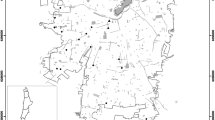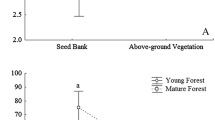Abstract
Urban areas around the world are rapidly expanding, with flow-on consequences for the native plants and animals that inhabit these areas. The impacts of this urban growth are not always immediate, and in the case of the local extinction of plant species may take up to 100–150 years. Understanding how urbanization affects ecological patterns and processes may allow us to minimize the loss of species from these areas through better planning and conservation decisions. This study examined the composition of the soil seed bank in remnant patches of grassy woodland along an urbanization gradient in northern Melbourne, Australia, using an ex-situ glasshouse germination trial. A total of 108 species emerged from the soil seed bank, although a majority of the seedlings were seeds from 19 non-indigenous monocot species. Species richness per plot of emergent seedlings was best explained by average annual rainfall, rather than the degree of urbanization in the surrounding landscape. This indicates that the existing plant community may be responding to a natural productivity gradient. The persistence of 123 indigenous plant species in the existing vegetation, even when the soil seed bank is dominated by non-indigenous monocot species, suggests that these plant communities can exist within urban areas, particularly in combination with appropriate management activities that ensure the continuation of previously occurring natural processes.


Similar content being viewed by others
References
Albrecht H, Eder E, Langbehn T, Tschiersch C (2011) The soil seed bank and its relationship to the established vegetation in urban wastelands. Landsc Urban Plan 100:87–97
Australian Bureau of Meteorology (2000) Average annual rainfall across greater Melbourne. Bureau of Meteorology, Melbourne
Australian Bureau of Statistics (2003) Melbourne- a social atlas 2001–2030, 2nd edn. Australian Bureau of Statistics, Canberra
Baker HG (1974) The evolution of weeds. Annu Rev Ecol Syst 5:1–24
Bastin L, Thomas CD (1999) The distribution of plant species in urban vegetation fragments. Landsc Ecol 14(5):493–507
Bossuyt B, Honnay O (2008) Can the seed bank be used for ecological restoration? An overview of seed bank characteristics in European communities. J Veg Sci 19:875–844
Bossuyt B, Heyn M, Hermy M (2002) Seed bank and vegetation composition of forest stands of varying age in central Belgium: consequences for regeneration of ancient forest vegetation. Plant Ecol 162(1):33–48
Carroll EJ, Ashton DH (1965) Seed storage in soils of several Victorian plant communities. Vic Nat 82:102–110
Clarke PJ, Davison EA, Fulloon L (2000) Germination and dormancy of grassy woodland and forest species: effects of smoke, heat, darkness and cold. Aust J Bot 48(6):687–700
Department of Conservation and Environment (1992) Draft conservation program for native grasslands and grassy woodlands in Victoria. Department of Conservation and Environment, Melbourne
Department of Natural Resources and Environment (2002a) Ecological vegetation classes. Department of Natural Resources and Environment, Melbourne
Department of Natural Resources and Environment (2002b) Ecological vegetation classes pre-1750. Department of Natural Resources and Environment, Melbourne
Fenner M, Thompson K (2005) The ecology of seeds. Cambridge University Press, Cambridge
Gioria M, Pyšek P, Moravcová L (2012) Soil seed banks in plant invasions: promoting species invasiveness and long-term impact on plant community dynamics. Preslia 84:327–350
Grant CD, MacGregor CM (2001) Topsoil seed banks in grazed and ungrazed eucalypt woodlands at Newholme, Armidale, New South Wales, Australia. New Zeal J Bot 39:471–481
Grimm NB, Grove JM, Pickett STA, Redman CA (2000) Integrated approaches to long-term studies of urban ecological systems. Bioscience 50(7):571–584
Guntenspergen GR, Levenson JB (1997) Understorey plant species composition in remnant stands along an urban-to-rural land-use gradient. Urban Ecosyst 1(3):155–169
Hahs AK (2006) Measures of urbanisation and the ecology of remnant woodlands along an urban-rural gradient. PhD, The University of Melbourne, Melbourne
Hahs AK, McDonnell MJ (2006) Selecting independent measures to quantify Melbourne’s urban-rural gradient. Landsc Urban Plan 78(4):435–448. doi:10.1016/j.landurbplan.2005.12.005
Hahs AK, McDonnell MJ (2007) Composition of the plant community in remnant patches of grassy woodland along an urban-rural gradient in Melbourne, Australia. Urban Ecosyst 10(4):355–377
Hahs AK, McDonnell MJ, McCarthy MA, Vesk PA, Corlett RT, Norton BA, Clemants SE, Duncan RP, Schwartz MW, Thompson K, Williams NSG (2009) A global analysis of plant extinction rates in urban areas. Ecol Lett 12(11):1165–1173. doi:10.1111/j.1461-0248.2009.01372.x
Hammer Ø, Harper DAT, Ryan PD (2001) PAST: Paleontological Statistics Software Package for education and data analysis. Palaeontol Electron 4(1):9
Holl KD, Crone EE, Schultz CB (2003) Landscape restoration: moving from generalities to methodologies. Bioscience 53(5):491–502
Howard TG, Gurevitch J, Hyatt L, Carreiro M, Lerdau M (2004) Forest invasibility in communities in southeastern New York. Biol Invasions 6:393–410
Howe C, Jones RN, Maheepala S, Rhodes B (2005) Melbourne water climate change study-implications of potential climate change for Melbourne’s water resources. A collaborative project between Melbourne Water and CSIRO Urban Water and Climate Impact Groups, Melbourne
Jutila HM (2003) Germination in Baltic coastal wetland meadows: similarities and differences between vegetation and seed bank. Plant Ecol 166(2):275–293
Kent M, Coker P (1992) Vegetation description and analysis: a practical approach. CRC Press, Ann Arbor
King SA, Buckney RT (2001) Exotic plants in the soil-stored seed bank of urban bushland. Aust J Bot 49:717–720
Kostel-Hughes F, Young TP, McDonnell MJ (1998) The soil seed bank and its relationship to the above ground vegetation in deciduous forests in New York City. Urban Ecosyst 2(1):43–61
Lake JC, Leishman MR (2004) Invasion success of exotic plants in natural ecosystems: the role of disturbance, plant attributes and freedom from herbivores. Biol Conserv 117(2):215–226
Leck MA, Parker VT, Simpson RL (eds) (1989) Ecology of soil seed banks. Academic Press, Inc., San Diego, CA
Lodge DM (1993) Biological invasions: lessons for ecology. Trends Ecol Evol 8(4):133–137
Lunt ID (1990) The soil seed bank of a long-grazed Themeda triandra grassland in Victoria. Proc R Soc Vic 102(1):53–58
Lunt ID (1997) Germinable soil seed banks of anthropogenic native grasslands and grassy forest remnants in temperate south-eastern Australia. Plant Ecol 130:21–34
McCarthy MA (2007) Bayesian methods for ecology. Cambridge University Press, Cambridge
McDonnell MJ, Hahs AK, Breuste JH (eds) (2009) Ecology of cities and towns: a comparative approach. Cambridge University Press, Cambridge
Morgan JW (1998a) Comparative germination responses of 28 temperate grassland species. Aust J Bot 46(2):209–219
Morgan JW (1998b) Composition and seasonal flux of the soil seed bank of species-rich Themeda triandra grasslands in relation to burning history. J Veg Sci 9(2):145–156
Oates A, Taranto M (2001) Vegetation mapping of the Port Phillip and Westernport Region. Arthur Rylah Institute for Environmental Research, Melbourne
Odgers BM (1994) Seed banks and vegetation of three contrasting sites in an urban Eucalypt forest reserve. Aust J Bot 42(4):371–382
Pickett STA, McDonnell MJ (1989) Changing perspectives in community dynamics: a theory of successional forces. Trends Ecol Evol 4:241–245
Rejmánek M (1996) A theory of seed plant invasiveness: the first sketch. Biol Conserv 78:171–181
Ross JH, Walsh NG (2003) A census of the vascular plants of Victoria, 7th edn. Royal Botanic Gardens, South Yarra
Schaefer V (2009) Alien invasion, ecological restoration in cities and the loss of ecological memory. Restor Ecol 17:171–176
Scott AJ, Morgan JW (2012) Resilience, persistence and relationship to standing vegetation in soil seed banks of semi-arid Australian old fields. Appl Veg Sci 15:48–61
Simpson RL, Leck MA, Parker VT (1989) Seed banks: general concepts and methodological issues. In: Leck MA, Parker VT, Simpson RL (eds) Ecology of soil seed banks. Academic Press, Inc., San Diego, CA, pp 3–8
Soil Conservation Authority (2001) Soils of Melbourne. In: Australian Plants Society Maroondah (ed) Flora of Melbourne. Hyland House, Melbourne, pp 14–16
Spiegelhalter DJ, Best NG, Carlin BP, van der Linde A (2002) Bayesian measures of model complexity and fit. J Roy Stat Soc B 64:583–639
Thackway R, Cresswell ID (1995) An interim biogeographic regionalisation for Australia: a framework for setting priorities in the National Reserves System Cooperative Program. Reserve System Unit. Australian Nature Conservation Agency, Canberra
UNFPA (2007) State of the world population 2007: unleashing the potential urban growth. United Nations Population Fund, New York
Victorian State Government (2009) Victoria in future 2008: Victorian state government population and household projections 2006–2036. Victorian State Government, Melbourne
Yates CJ, Hobbs RJ, Bell RW (1994) Factors limiting the recruitment of Eucalyptus salmonophloia in remnant woodlands. I. Pattern of flowering, seed production and seed fall. Aust J Bot 42:531–542
Yates CJ, Taplin R, Hobbs RJ, Bell RW (1995) Factors limiting the recruitment of Eucalyptus salmonophloia in remnant woodlands. II. Post-dispersal seed predation and soil reserves. Aust J Bot 43:145–155
Williams NSG, Schwartz MW, Vesk PA, McCarthy MA, Hahs AK, Clemants SE, Corlett RT, Duncan RP, Norton BA, Thompson K, McDonnell MJ (2009) A conceptual framework for predicting the effects of urban environments on floras. J Ecol 97:4–9
Acknowledgments
AKH was a recipient of an Australian Post-graduate Award (with stipend) whilst conducting this research. The Baker Foundation, the Royal Botanic Gardens Melbourne and the School of Botany at The University of Melbourne provided additional funding and support. Mick McCarthy helped with the Bayesian statistics, and Margaret Carreiro and Richard Hobbs provided helpful comments on a previous version of this research. Steve Elefteriadis, Terry Coates, and Ron Teo provided technical support. This manuscript was improved by comments from two anonymous reviewers.
Author information
Authors and Affiliations
Corresponding author
Electronic supplementary material
Below is the link to the electronic supplementary material.
Rights and permissions
About this article
Cite this article
Hahs, A.K., McDonnell, M.J. Composition of the soil seed bank in remnant patches of grassy woodland along an urbanization gradient in Melbourne, Australia. Plant Ecol 214, 1247–1256 (2013). https://doi.org/10.1007/s11258-013-0248-0
Received:
Accepted:
Published:
Issue Date:
DOI: https://doi.org/10.1007/s11258-013-0248-0




